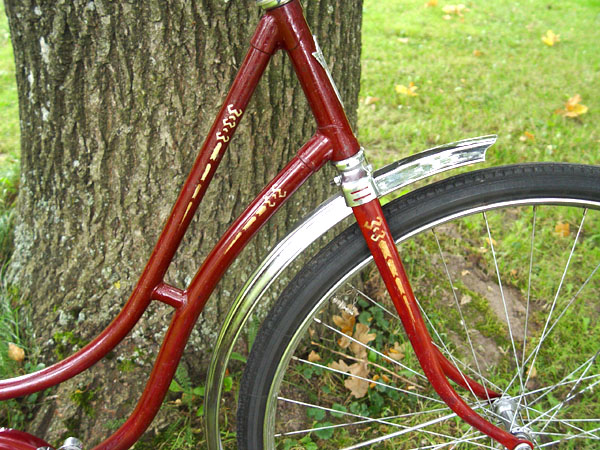The 1950s
In the early 1950s, Riga Bicycle Factory Sarkana Zvaigzne (Red Star in Latvian), restructured from pre-war Erenpreis factory, achieved large production volumes. Similar to Estonia, Latvia was also incorporated into the Soviet Union in the course of the World War II, and after the war, Riga became the closest Soviet city with large-scale bike manufacture. When there were no more reparation bikes received from Germany (in ca. 1953-54), the bicycles available in local distribution network consisted mostly in the production of Riga factory.
Men’s bicycle model Riga-10 and women’s bike model Riga-20 were rather widespread. In terms of construction, they combined both the traditions of pre-war Erenpreis factory and the imitations of the best pre-war and reparation bike models. In the 1950s, the quality of Riga bicycles was much higher than that of other Soviet bike factories, although not as good as the quality of pre-war bicycles. Riga was also the only bike factory in the USSR to develop its own models instead of adjusting standard Soviet models, as other factories did.
After slight modernisation of bicycles from Riga factory in 1958 (new men’s bike was named Riga-16 and women’s bike Riga-26), the production volume and popularity of the bikes increased even further. In the late 1950s, the bikes made in Riga were significantly more noticeable on local roads and streets than pre-war vehicles. Bicycles from Riga factory had pleasant design in black, blue, green and red colour; there were models with both painted and chromed mudguards and wheels. Riga bikes were the only ones in the Soviet Union equipped with pretty textile dress guards that reminded those from pre-war times. Other factories in the Soviet Union used simple rubber guards.
Unfortunately, the peak sales of Riga factory bicycles lasted only a few years, as it discontinued manufacturing ordinary bicycles in 1961 (and started to produce motorised bicycles).
In the 1950s, Estonia also received some production of other bicycle factories. The produce of Kharkov factory had the highest quality. Kharkov bicycle factory was the successor of Leutner (Leitner) factory evacuated from Riga to central Russia in 1915, where it quickly became the greatest bike factory in the Soviet Union. At that time, Kharkov factory (similar to ZIS car factory, Lvov bicycle factory, etc.) manufactured standard men’s bike B-110, largely based on the structure of German reparation bicycles.
Interestingly, although size 28" wheels remained dominant in bikes throughout the Soviet period until the end of the 1980s, there were frequent attempts to produce women’s bikes with 26" wheels in the 1950s (apparently by the example of Mifa reparation bicycles). However, this wheel size was discarded in the 1960s, and due to lack of tyres, people eventually stopped using such bikes or got rid of them.

